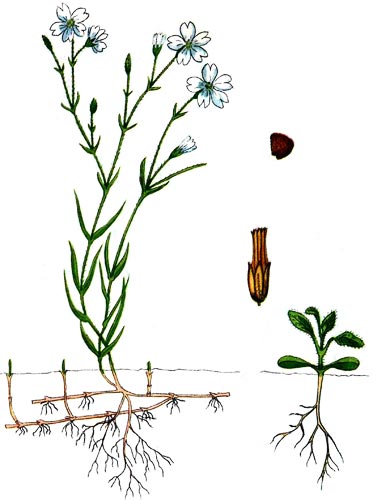Weeds
Cerastium arvense L. - Field Chickweed.
Systematic position.
Family Caryophyllaceae Juss., genus Cerastium L.Biological group.
Perennial weed.Morphology and biology.
Plant 10-40 cm in height. Stalks branchy at base, with outstretched non-blossoming or with upright blossoming branches; covered with simple deflected downward hairs in the lower part, with mixture of the simple and glandular hairs in the upper part; sometimes all plant completely glabrous (var. glabellum (Turcz.) Fenzl), with lengthened upper internodes. Leaves lanceolate or widely linear (var. angustifolium Fenzl), 1-2 cm in length and 1.5-4 mm in width, sometimes oblong-ovoid (var. latifolium Fenzl), somewhat pointed, shortly pubescent. Shoots either shortened or lengthened, fruitless, risen from leaf sheaths. Flowers located on stalk tips in rather thin semi-umbel; bracts glumaceous at apex and along margins. Anthophores 2-3 times as long as calyx, upright at fruits, bent above. Sepals ovoid-lanceolate, 4-6 mm in length and 1.5-2 mm in width, blunt, covered with short glandular hairs, widely scarious along margins. Petals 2-2.5 times as long as calyx, incised at tip by 1/3 of their length. Boll 1.5 times as long as calyx, hardly bent above, with straight teeth that are bent along margins. Seeds pyriform, slightly compressed laterally, widely rounded on one end, blunt-beaked on the other end, 1-2 mm in length and 0.8 mm in width. Their surface fulvous, shining, with concentrically located tubercles. Blossoming from May until August. One plant produces 300 (220-700) seeds.Distribution.
Scandinavia, Middle and Atlantic Europe, Mongolia, Japan, China, Northern America, Greenland. In the former USSR, the species is distributed in Arctic regions, in the European part, in the Caucasus, Western and Eastern Siberia, the Far East, Central Asia.Ecology.
The species grows in meadows, low-density forests, among bushes, in habitations, in crops. It prefers dry, warm, sandy, alkaline ground.Economic significance.
The weed litters crops of perennial grasses and fallow fields, seldom meeting in crops of field and truck cultures. Control measures include stubbling, deep autumn plowing, preseeding treatment of ground, the use of sorted seeds only, early grass mowing in meadows, thorough soil treatment and sowing, clean fallows, destruction of the weed in uncultivated places, application of herbicides if necessary.Reference citations:
Anon. 1996. Weeds on sugar beet. Berlin: Hoehst Shering AgrEvo Gmbh. 479 p. (in Russian).Keller B.A., ed. 1934. Weed plants of the USSR. V. 2. Leningrad: AN SSSR, 244 p. (in Russian).
Komarov V.L. & Shishkin B.K., eds. 1936. Flora of the USSR. V. 6. Moscow & Leningrad: AN SSSR. 954 p. (in Russian).
Nikitin V.V. 1983. Weeds in the flora of the USSR. Leningrad: Nauka. 454 p. (in Russian).


